While campaigning has effectively been ongoing since November, the six state election campaigns are gaining traction with polls just a month away.
With a heightened campaign comes important questions about what will happen and why.
This series of articles – exclusive for Malaysiakini – will look in-depth at dynamics in the August state elections, drawing from fieldwork before and during the official campaign period and statistical analysis of voting.
Articles will focus on critical swing voters and drivers of electoral outcomes, individual states, the challenges of particular political parties, the campaign and potential outcomes.
I will also be featuring an in-depth analysis of individual seats in a podcast series with Malaysiakini entitled “Kerusi Panas” during the official campaign, a series originally founded by Between the Lines.
This first article in the series looks at where the political terrain stands now, before the nomination of candidates on July 29 and before the official campaign.
It is important to begin with a qualifying caveat, as these scenarios should be understood to be very preliminary. Two important dynamics still lie ahead: candidate nomination and the official campaign.
Campaigns have historically proven to be decisive in shaping outcomes and are especially important given the considerable share of undecided voters, especially among younger voters.
Candidates also shape outcomes, as does the use of resources to sway voters and narratives. So, please readers, see these scenarios as describing the breadth of the electoral landscape, with voters the ones who will decide which of these paths will emerge.
A competitive poll
Let’s begin the analysis. Looking closely at the seats shows that the August state elections will be competitive. This should come as no surprise as Malaysia’s electoral democracy is robust.

The states that are the most competitive are Selangor and Kedah, but note that nearly a third of the seats are competitive in all of the states going to polls.
Understanding prospective voting
Given that this election is different, the analysis of potential voting needs to be more complex.
It needs to take into account potential crossover (also known as transferability) across traditional party loyalties, undecided voters, various patterns or turnout (some states have more outside voters than others) as well as different configurations and electoral histories in particular seats.
Questions such as how many voters will likely come out to vote or how many voters who have voted for one party/coalition all their life will change their loyalties due to an alliance in the unity government have to be answered preliminarily to determine competitiveness.
To do this, I draw from pre-nomination fieldwork to all six states, speaking to voters individually and in focus groups about their preferences and concerns. The fieldwork has allowed me to determine a range of what patterns or turnout and crossover might emerge.
I also draw from an analysis of the data in the seats, tied to the post-GE15 election electoral roll (Q12023). I use two lenses to look at voting at the polling station levels (the smallest unit for voting estimates) - ethnic and age voting patterns.
I also review the class, urbanisation and demographic composition of the seat from a lens of what type of voters are in a particular seat, such as military and police or Felda settlers.
As noted in my earlier research, voting is shaped by multiple factors. A crucial starting point is to recognise that each state has its own dynamics and electoral history.
As such, it is necessary to incorporate multiple analytical lenses to understand prospective trends.
Pre-nomination scenarios
Below I present three different scenarios. These reflect the work and consolidation of multiple (over eight) different scenarios in each state.
The three scenario clusters are drawn from projections that vary turnout, cross-over of votes from party supporters to different coalitions and changes in support across age and ethnicity.
The decision to put a particular seat in one column or another reflects a judgement of the cluster of similar scenarios that vary in multiple variables.
These scenarios are based on a two-party contest – Perikatan Nasional (PN) and unity (Pakatan Harapan and BN), so at this juncture they leave out Muda and another other party/independent that might run. As noted, these scenarios are pre-nomination.
These scenarios are prepared to understand the complex electoral terrain, and the possibilities of different configurations of power.
There is the constant refrain of status quo, but a close look at the situation on the ground reaffirms that things are moving and changing – and will likely change again (even modestly) when polling happens next month.
Here are the three different scenario clusters. The first – the “PN Blowout” - draws from the most touted discussion of the opposition PN gaining further ground. PN has been gaining at the polls since the Malacca 2021 election and hopes to translate gains at the federal level in GE15 to the six states election.
The main party in PN – PAS – holds three of the state governments to be contested. I contend that the coming polls will be a more substantive test of the “Green Wave” (a theme I will delve into in another piece later this month).
“PN Blowout” draws from scenarios that extend PN electoral gains, predominantly from erosion of support from Umno/BN. It also looks at gains that might occur from younger voters to PN – where, as noted earlier in my generation piece, these varied considerably across states.
The second scenario “Modest PN Gains” is based on the assessment that more voters could vote for PN, but not as much as being touted, i.e., claiming to reach 70 to 80 percent of Malay vote (Padang Serai levels) or 60 percent of youth voters (found in the northern Malay heartland but not in more diverse, West Coast states).
Using the baseline of the GE15, these scenarios assess differences in support for PN acknowledging modest gains locally, including a small reduction of support in some areas from young voters.
Here the premise is that PN’s support remains strong, but may have peaked in GE15, influenced by the “Abah (Muhyiddin Yassin) factor” and recognising in some states that opposition to PAS remains significant.
This is balanced by a recognition that Umno grassroots continue to erode among Malay voters, especially in areas where PAS is dominant. This second cluster aims to capture these different trends.
A final scenario “The Anwar Govt Boost” draws from a cluster of scenarios that acknowledge in some areas that Anwar’s government has gained support, with many voters willing to “give it a chance”.
Fatigue with instability and politicking is real. Voters want the elections to be over so a focus will be on governing and policies.
Here the undecided voters are particularly crucial, younger voters. Also embedded in the Anwar government boost discussion is a recognition that some incumbent governments at the state level are more popular than others, and the Anwar government factor works in favour of some state governments, such as on the West Coast (notably Selangor and Penang with less salience in Kedah).
This third scenario shows what can happen if the Anwar government and its component parties - that arguably has yet to have a clear narrative and working campaign - gain ground.
While many would tout that the federal government wrestles with meeting expectations in a more demanding electorate, they are still a new government of eight months, with considerable goodwill among many voters.
These three scenarios aim to capture the variation of possibilities. Again, these scenarios should be understood to show the variation in Malaysia’s highly dynamic electorate.
I have three categories – Perikatan Nasional (PN), unity (Pakatan Harapan and Barisan Nasional) and TCTC (too close to call), seats where the margins of victory at this preliminary stage are less than five percent. The numbers in the bar charts refer to potential total seats that fall in the respective category.
The PAS Malay heartland
Here we go: All indications are that even before the official campaign, PAS will retain all three of the states. For some observers, the question has been whether the unity government will be able to hold its own - to hold onto its incumbent seats.
PAS remains very strong in Kelantan, Terengganu and Kedah, in the latter where the incumbent Menteri Besar Muhammad Sanusi Md Nor has dominated the headlines.
Analytically, a key issue is whether PAS will win two-thirds of the vote, a crucial threshold to change state constitutions. This possibility exists in all three states, including the more competitive states of Kedah and Terengganu.
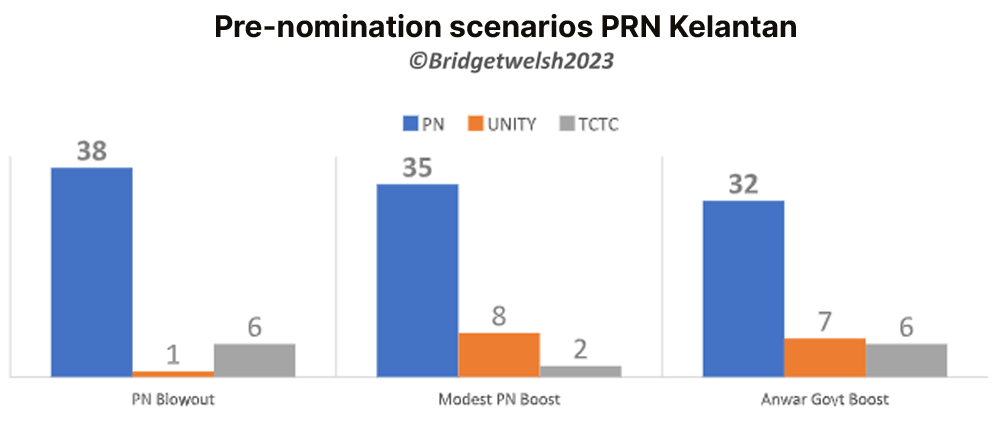
It is in these same states of Terengganu and Kedah where the contest to maintain a third of the seats is the most intense. From Kijal in Kemaman to Bandar Baharu in Kulim, the fight is on.
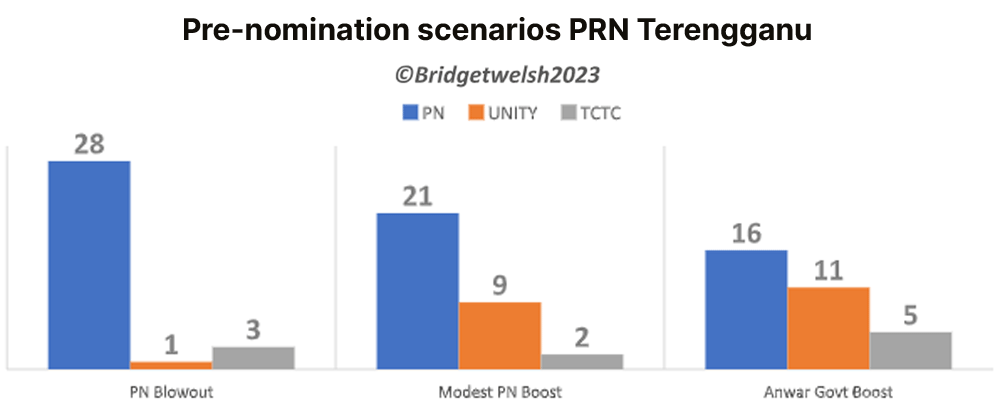
To appreciate the intensity of the competitiveness, to see the changes in the potential performance of the Anwar unity government, from being potentially annihilated to holding a third of the power.
Campaigns in these states have been largely ignored by the federal government to date, even though many of the seats are competitive.
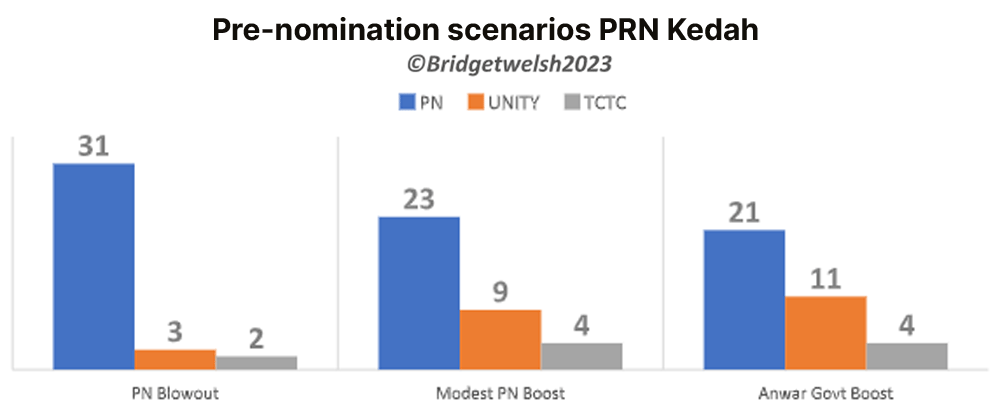
Pakatan core states
Incumbent state governments on the other political side of Malaysia are also facing their own battles to hold onto support.
This is the case where Harapan (before 2015 as Pakatan Rakyat) has held power in Penang and Selangor since 2008. No question, the opposition PN has gained ground in GE15 and is aiming to translate these gains at the state levels.
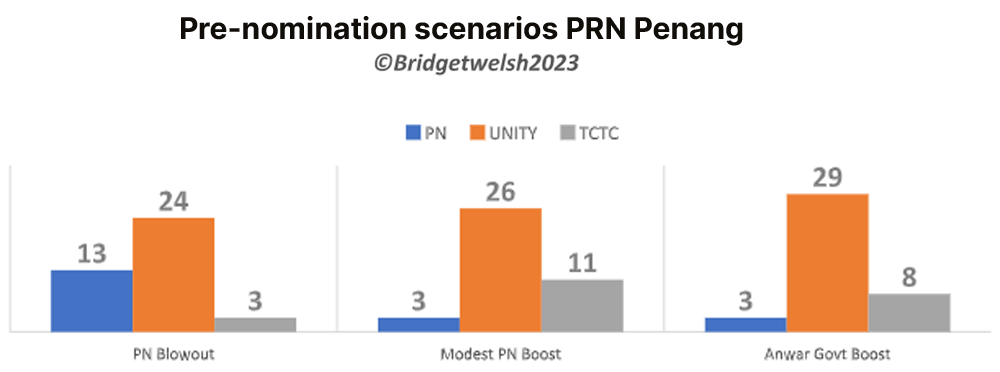
The “PN Blowout” scenario in both Penang and Selangor shows that if this occurs, PN will break the two-thirds in Penang and go beyond this in Selangor.
While many seats in this scenario are TCTC, ground research weighs these in favour of the incumbent Harapan governments to retain most of their seats.
In both Penang and Selangor, the incumbent government is more popular than the federal government. This is particularly the case in Selangor among Malay voters and among Chinese voters in Penang.
There is an inadequate appreciation that voters understand that the state and federal governments are different. At this juncture, the odds of PN winning the Selangor government are slim, although the possibility cannot be ruled out completely.
The other scenarios - the “Anwar Govt Boost” and “Modest PN Boost” - are also credible paths ahead. Anwar is from Penang and this matters among many voters. It is in these two states where resistance to PAS is also among the strongest.
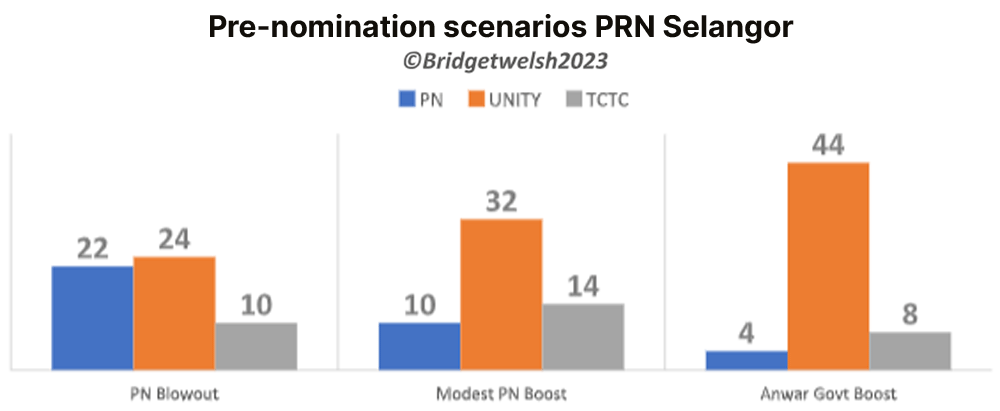
Special ‘Negeri’
The pattern of support in Negeri Sembilan is distinct. PKR has a shorter tenure here, only winning the government of the state in 2018.
The changes in support in recent years are also unique. In GE15, PN was weakest here. PAS does not have the same base as it has elsewhere in Negeri Sembilan.
Under the leadership of Mohamad Hassan (Tok Mat), Umno held its own electorally in GE15. Along with Terengganu, Negeri Sembilan is the frontline state to maintain electoral support for the grand old party.
Of the three clusters of scenarios, the “PN Blowout” is the least likely in Negeri Sembilan because of the patterns of electoral support. Yet to maintain consistency in the analysis, I develop all three alternatives.
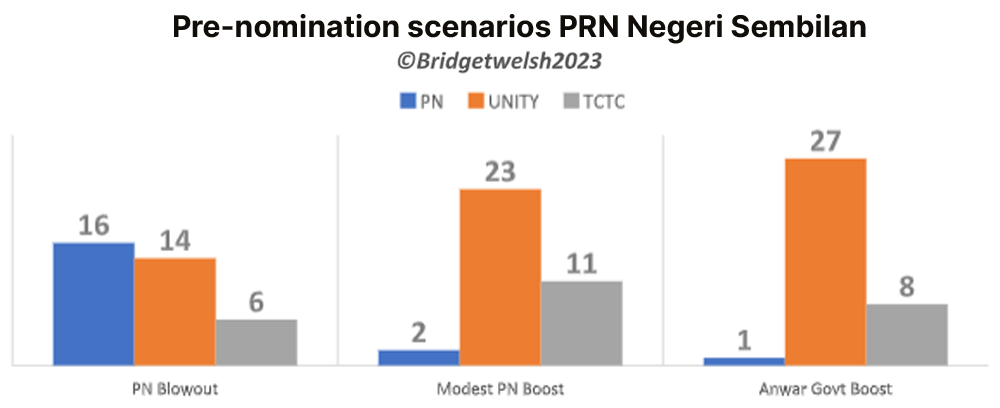
What is at play on the ground in Negeri Sembilan is the strength of Umno, turnout and crossover voting as traditional loyalties are strong. Crossover willingness (based on focus groups) appears to be lower than in Penang and Selangor.
With PAS having less of a base in the state, conditions favour the other scenarios to a greater degree than is the case elsewhere.
What will be interesting to watch is how Umno fares and whether crossover and turnout for the Anwar unity government will be high enough to move the scenarios toward a comfortable working majority of victory.
Looking ahead
There is indeed a lot to watch for, and more analysis of different dimensions in-depth will follow.
I caution readers not to overinterpret these pre-nomination scenarios. They aim to show you the variation in possible outcomes and different potential trajectories.
To date, the focus has been on one of these, a PN victory, rather than a more balanced assessment of different possibilities, including gains for the Anwar government compared to GE15.
Crucial to remember that it is voters who are the ones who have the power – they are the ones who will decide.
Malaysians embrace and use their voting power and given the mega nature of the coming polls, the excitement in the campaign (which is not there yet) will build (perhaps when the unity government develops a clearer, more focused narrative). The candidates and campaign will follow, transforming contests (and creating the need for revised projections).
All indications at this juncture, however, are that while governments may not change from one coalition to another, the balance of power within states may likely do so.
In this regard, and in the intensive contestation that will follow, it is not a “status quo” state polls at all. - Mkini
BRIDGET WELSH is an honorary research associate of the University of Nottingham, Malaysia’s Asia Research Institute (Unari). She is also a senior research associate at the Hu Fu Centre for East Asia Democratic Studies and a senior associate fellow of The Habibie Centre. Her writings can be found at bridgetwelsh.com.
The views expressed here are those of the author/contributor and do not necessarily represent the views of MMKtT.




No comments:
Post a Comment
Note: Only a member of this blog may post a comment.